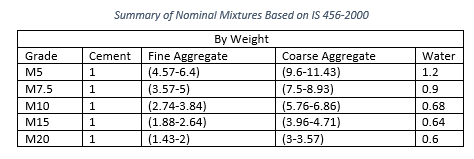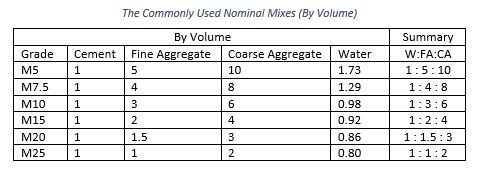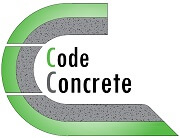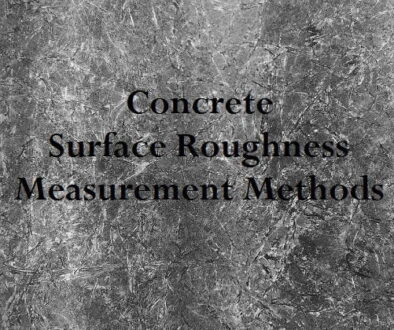Concrete Mix Proportioning (Ratio & Design) Indian Method

Last updated on April 15th, 2022
What is mix proportioning
Concrete mix proportioning, or mix designing, is the process of selecting the suitable amount of each ingredient in such a way to meet the desired requirements. This process can be performed based on national or international standards, practices, guidelines, or specifications, such as the IS, BS, or ACI. In general, they are somehow in-line and similar in the broad perspective. However, each standard or guideline has its own procedure with its specific limits and controlling parameters. In brief, this article introduces mix proportioning based on the Indian standard.
Introduction to the Indian method for concrete mix proportioning
Mix proportioning based on the Indian method is briefly a procedure based on a set of guidelines, standards, and specifications. These mainly include the IS 456 and IS 10262, in addition to many others.
In general, a concrete mix ratio shall be selected or designed to obtain specific properties including:
- Workability.
- Mechanical properties.
- Durability.
- And aesthetics.
Mix proportioning: Determining the mix ratio for concrete
In the Indian method, there are two ways for determining the mix proportions of concrete, the “nominal mix” and “design mix”, according to the terminology in the IS codes.
The difference between nominal mix and design mix
In the nominal mix method, the user simply selects a readily available nominal concrete mix ratio. Whereas in the design mix method, the user actually designs the concrete mixture based on several factors. The latter is certainly a better, and is much more accurate and practical.
Method 1: Selecting a nominal mix
This method is usually undesirable since the properties of concrete may vary with the variations in the properties of raw materials. However, many still use this method when the method of concrete design mix is not applicable for any reason. In such a case, nominal mixtures with a grade of M20 or less can be selected. However, the cement content is likely to be higher when using this method.
The proportions of nominal mixtures are detailed in IS 456, and are summarized as follows.

In addition to the previous table, the following one shows the commonly used nominal mixes by volume, which are close to those in the previous table. However, it is important to note that this table is not based on the IS 456-2000.

In addition, the standard provides additional data to take into account the effect of the moisture content of aggregates. This data can be used in case the test results of the moisture content are not available.
Method 2: Designing a mixture based on the concrete design mix
What is design mix concrete?
It is basically a method for determining the proportions of materials in a concrete mixture, following a practical guideline based on the IS code. In this method, the user follows a procedure and takes into account various factors that can influence the final proportions.
However, before getting into the process of design mix concrete, it is vital to determine first the basic conditions and controlling data.
Determining the basic conditions and controlling factors for the design mix method
The first and most important part in concrete design mix or even in nominal mix is to determine the basic required data. This data includes:
- Application.
- Exposure conditions.
- Material availability.
- Placement methods.
- Weather conditions.
- Aesthetic requirements.
Then based on this data, the basic controlling limits of the design mix concrete can be set, which include:
- Required properties, such as the compressive strength, slump, durability, etc… .
- Material choice and properties, such as the type of cement, supplementary cementitious materials, aggregates, admixtures, etc… .
- Maximum aggregate size.
- Minimum cement content.
- Maximum water content.
- Mixing methods.
- Curing methods.
- Finishing methods.
- Quality control requirements.
- And others.
Step 1: Determining the target strength
The target mean compressive strength is a value higher than the characteristic compressive strength. This value helps in ensuring that the mixture achieves the specified characteristic strength. The target mean compressive strength is calculated, based on IS 10262-2009, according to the following equation:
Equation 1: First Equation for calculating the target mean compressive strength
f’ck = fck + 1.65 S
Where f’ck is the target mean compressive strength at 28 days in MPa, fck is the characteristic compressive strength at 28 days in MPa, and S is the standard deviation.
Besides, if the standard deviation (S) is not calculated, it can be assumed based on a given table. This table has values of assumed standard deviation for design mix concrete with a compressive strength up to 55 MPa in IS 10262-2009, and up to 80 MPa in IS 10262-2019.
However, if starting with the assumed standard deviation, it is important to calculate the actual value as soon as possible, with at least 30 specimens, and perform the suitable adjustments.
In addition, IS 10262-2019 introduced an additional equation for calculating the target mean compressive strength, in which the higher value of the two equations governs.
Equation 2: Second equation for calculating the target mean compressive strength
f’ck = fck + X
Where f’ck is the target mean compressive strength at 28 days in MPa, fck is the characteristic compressive strength at 28 days in MPa, and X is a factor related to the strength of the mixture, and given in a table.
After calculating the target mean compressive strength from equations 1 & 2, the higher value is used in the concrete design mix.
Step 2: Determining the water to cement ratio
Also, the guideline provides a specific chart to estimate the water to cement ratio. The chart relates the compressive strength and water to cement ratio for different classes of cement. In fact, the chart provides a rational estimation of the w/c in the concrete design mix. However, it is better to develop a relationship between the compressive strength and water to cement ratio for the specific materials in use.
In addition to the chart, the IS 456 provides limits for the water to cement ratio based on the durability. Thereby, the governing water to cement ratio is the smaller between the chart values and durability limits.
Furthermore, the water to cementitious materials, w/cm, should be used in case of incorporating supplementary cementitious materials (natural or artificial) in the mixture. This ratio must also meet the requirements of IS 456.
Step 3: Determining the air content
The IS 10262 provides a table which helps in estimating the air content. This table relates the entrapped air to the nominal maximum aggregate size.
Step 4: Determining the water content
Although we have passed through the process of determining the water to cement ratio in step 2, we have not explained the process of determining the water content yet.
In fact, the guidelines provide a table, table 4, to estimate the required water content for design mix concrete. The table mainly shows estimations for the water content based on a slump of 50 mm and for angular coarse aggregates. However, it also provides a method for adjusting the values for a different slump or particle shape.
Step 5: Determining the cement content
The cement content, or cementitious content, is determined based on the water content and water to cement ratio from step 4 and step 2. To illustrate, if we have already determined the water to cement ratio and the water content, the only unknown in the equation would be the cement content. However, the calculated value must be compared against the durability requirements in IS 456, and the higher minimum cement content governs.
In addition, the 2019 version of IS 10262 states that in some cases, when using high content of supplementary cementitious materials, the amount of cement should be slightly increased.
Step 6: Determining the volume of coarse aggregate
The guidelines also provide a table, table 5, which helps in determining the volume of the coarse aggregate in the design mix method. The table mainly shows estimations for the ratio of the volume of the coarse aggregate to the total volume of aggregates, based on a water to cement ratio of 0.5.
However, the 2019 version of IS 10262 provides a method for adjusting the volume of the coarse aggregate for varying water to cement ratios.
In addition, for pumpable concrete, the volume can be reduced by about 10%. However, it is important to check that other values still meet the requirements and limits of IS 456.
Moreover, adjustments can be made to take into account the particle shape of the coarse aggregate and the source of the fine aggregate.
Furthermore, the coarse aggregate must also meet the requirements of IS 383.
Step 7: Determining the content of fine and coarse aggregates
The absolute volume method helps in determining the content of aggregates. Thereby, the first step is to calculate the volume of cementitious materials, entrapped air, water, and admixtures. Then, the second step is to subtract the values from the required volume. The volume of each constituent can be determined by dividing its weight by its specific gravity, then dividing the value by 1000. Thereby, by subtracting the volume of the constituents from the required volume, we get the volume of aggregates.
Hence, the third step is to determine the individual volumes of both fine and coarse aggregates. Then, the fourth step is to determine the weight of the fine and coarse aggregates by multiplying the volume by the specific gravity and by 1000.
In addition, the moisture content and water absorption should be taken into consideration for proper adjustments to the design mix concrete.
Step 8: Trial mixes
Furthermore, the guideline provides a method for performing trial mixtures. The first trial mixture aims to check the compressive strength, workability, segregation, bleeding, and surface appearance. Then based on the results, adjustments to the proportions of the design mix are usually made to achieve the required slump values. Thereby, the adjustments are mostly in the water to cement ratio or the content of admixtures.
Consequently, the second trial mixture is a mixture having the adjusted values. Then, after achieving the required properties with this mixture, two additional trial mixtures are needed.
The third and fourth trial mixtures have +10% and -10% water contents respectively. These mixtures should try to maintain the workability requirements by adjusting the content of admixtures.
In brief, by following this procedure on trial mixtures, trials 2, 3, and 4 help in establishing a primary relationship between the strength and water to cement ratio. However, it is important to satisfy the durability requirements in this procedure as well. In addition, the guideline recommends further field tests.
Example
Use the concrete design mix method to determine the proportions of a concrete mixture based on the following data:
- Concrete class: M35
- Type of cement: OPC 33 having a specific gravity of 3.15.
- Supplementary cementitious material: Fly-ash as a partial replacement of cement at 15% by weight, having a specific gravity of 2.15.
- Maximum aggregate size: 20 mm.
- Application: reinforced concrete.
- Exposure condition: very severe as per IS 456.
- Slump: 100 mm.
- Placing method: pumping.
- Quality control: excellent.
- Coarse aggregate: angular having an SSD specific gravity of 2.80, absorption 0.8%, moisture content 2%.
- Fine aggregate: sand of zone II based on IS 383, having an SSD specific gravity of 2.65 absorption 1.2%, moisture content 3%.
- Admixtures: Water reducer, having a water reduction capacity of 18% at a dosage of 1% by weight of cementitious materials, having a specific gravity of 1.10.
- Use assumed standard deviation.
1) Step 1: Determine the target mean compressive strength
The assumed standard deviation value is taken from table 2 in IS 10262-2019, where S = 5 MPa for M35.
And the value X is taken from table 1 in IS 10262-2019, where X = 6.5 for M35.
Thereby, by substituting the values into equations 1 and 2, the governing target mean compressive strength is 43.25 MPa.
f’ck = fck + 1.65 S = 35 + 1.65 * 5 = 43.25 MPa.
f’ck = fck + X = 35 + 6.5 = 41.5 MPa.
Step 1 >> f’ck = 43.25 MPa.
2) Step 2: Determine w/c
Based on figure 1 in IS 10262-2019, the water to cement ratio for OPC 33 and a target mean compressive strength of 43.25 MPa, the w/c is about 0.35.
In addition, based on table 5 in IS 456-2000, M35 design mix is sufficient for reinforced concrete in a very severe condition, and the water to cement ratio must be lower than 0.45.
Thereby, the governing w/c is 0.35.
Step 2 >> w/c = 0.35.
3) Step 3: Determine the air content of the design mix
Based on table 3 in IS 10262-2019, the approximate air content from a mixture with a maximum nominal aggregate size of 20 mm is 1%.
Step 3 >> Air = 1%.
4) Step 4: Determine the water content
Based on table 4 in IS 10262-2019, the water content for a mixture with maximum nominal aggregate size of 20 mm is 186 kg/m3. However, this value corresponds to a slump of 50 mm. Whereas, the slump intended in this example is 100 mm. Thereby, an adjustment should be made. Hence, based on section 5.3 in IS 10262-2019, we should increase the water content by 3% for every 25 mm increase in slump beyond 50 mm. Thereby, this yields an increase of 6% in the water content for this concrete design mix, and the adjusted value is calculated as follows.
186 + (186 * 6/100) = 197.16 ~ 197 kg/m3.
In addition, we are using a water-reducing admixture at a dosage of 1% with a water reduction capacity of 18%. Thereby, the second adjustment on the water content is as follows.
197 – (197 * 18/100) = 161.54 ~ 161.5 kg/m3
Step 4 >> water = 161.5 kg/m3.
5) Step 5: Determine the content of cementitious materials
We already have the following data: w/c = 0.35, and water = 161.5 kg/m3. Thereby, the variable (c) is calculated as follows.
c = 161.5/0.35 = 461.43 kg/m3
Checking against the durability requirement in table 5 in IS 456-2000, the minimum required cement content for very severe exposure of reinforced concrete is 340 kg/m3. Thereby, 461.43 is adequate.
However, in this design mix example, we are also using fly-ash as a partial replacement of cement at 15% by its weight. Thereby the amount of fly-ash needs to be calculated and the amount of cement to be adjusted, as follows.
fly-ash = 461.43 * (15/100) = 69.2 ~ 69 kg/m3.
and cement adjusted = 461.43 – 69.2 = 392.2 ~ 392 kg/m3.
Step 5 >> cement = 392 kg/m3 ; fly-ash = 69 kg/m3.
6) Step 6: Determine the volume of the coarse aggregate
Based on table 5 in IS 10262-2019, for a nominal maximum aggregate size of 20 mm and fine aggregate of zone II, the ratio of the volume of the coarse aggregate to the total volume of aggregate is 0.62.
However, this value is based on a water to cement ratio of 0.5, whereas our water to cement ratio is 0.35. Thereby we should adjust this value. Based on section 5.5.1 in IS 10262-2019, the value should be increased by 0.01 for ever decrease of 0.05 in the w/c below 0.5. Thereby, we should increase the value of 0.62 by 0.03 in this example, calculated as follows.
0.62 + (0.50 – 0.35)/0.05 * 0.01 = 0.65.
In addition, based on section 5.5.2 in IS 10262-2019, the value can be reduced up to 10% for concrete that is to be easily pumped. Thus we will use this reduction for the trial mixture. This yields a ratio of the volume of the coarse aggregate to the total volume of aggregates of 0.585, calculated a follows.
0.65 – (0.65*10/100) = 0.585
Step 6 >> ratio of the volume of the coarse aggregate to the total volume of aggregates = 0.585
7) Step 7: Determine the content of fine and coarse aggregates
By applying the absolute volume method, we have:
Cement volume = 392/3.15 * 1/1000 = 0.1244
Fly-ash volume = 69/2.15 * 1/1000 = 0.0321
Water volume = 161.5/1 * 1/1000 = 0.1615
Admixture volume = (461*1/100)/1.1 * 1/1000 = 0.0042
Entrapped air volume = 0.01
Thereby:
1 m3 = 0.1244 + 0.0321 + 0.1615 + 0.0042 + 0.01 + volume of aggregate
Volume of aggregates = 0.6678
However, in the previous step, we determined the ratio of the volume of the coarse aggregate to the total volume of the aggregates to be 0.585. Hence the volume of coarse aggregate is calculated as 0.39, as follows.
Volume of the coarse aggregate 0.6678 * 0.585 = 0.39
And, the volume of the fine aggregate is calculated as 0.2778, as follows.
Volume of the fine aggregate = 0.6678 – 0.39 = 0.2778.
Thereby, by multiplying the volume by specific gravity and by 1000, we get the weight of the aggregates per cubic meter of concrete, as follows.
Weight of the coarse aggregate = 0.39 * 2.8 * 1000 = 1092 kg/m3.
And the weight of the fine aggregate = 0.2778 * 2.65 * 1000 = 736 kg/m3.
Step 7 >> coarse aggregate SSD = 1092 kg/m3 and fine aggregate SSD = 736 kg/m3.
Hence, our design mix calculations yield the following proportions for concrete in the SSD condition of aggregates:
Cement : 392 kg/m3
Fly-ash : 69 kg/m3
Fine aggregate : 736 kg/m3
Coarse aggregate : 1092 kg/m3
Water : 161.5 kg/m3
Water reducer : 4.61 kg/m3
However, in order to take into account the moisture content and absorption of aggregates, which are actually not in SSD condition, a modification should be made as follows. Since the moisture content of both aggregates is higher than their absorption, then both aggregates contribute to the water content.
The fine aggregate has an absorption and moisture content of 1.2% and 3% respectively. Hence:
The adjusted weight of fine aggregate = 736 + 736 * (0.03-0.012) = 749.2 ~ 749 kg/m3 ; and the water contributed by the fine aggregate = 749 – 736 = 13 kg/m3.
The coarse aggregate has an absorption and moisture content of 0.8% and 2% respectively.
The adjusted weight of coarse aggregate = 1092 + 1092 * (0.02-0.008) = 1105.1 ~ 1105 kg/m3 ; and the water contributed by the coarse aggregate = 1105 – 1092 = 13 kg/m3.
Thereby, the adjusted water content = 161.5 – 13 – 13 = 135.5 kg/m3.
As a summary, our design mix calculations yield the following proportions considering the actual conditions of aggregates:
Cement : 392 kg/m3
Fly-ash : 69 kg/m3
Fine aggregate : 749 kg/m3
Coarse aggregate : 1105 kg/m3
Water : 135.5 kg/m3
Water reducer : 4.61 kg/m3
8) Step 8: Perform trial mixtures
Online calculators based on the IS method
Code Concrete developed two calculators based on the discussed methods.
- Concrete Nominal Mix Calculator (IS Code) is based on the nominal mix method.
- Whereas, Concrete Mix Proportioning Calculator (IS Code) is based on the design mix method.
Most importantly, these calculators take into account almost all the details required for precise proportioning.
Bibliography
- IS 456-2000, IS 383, IS 10262-2009, and IS 10262-2019.




